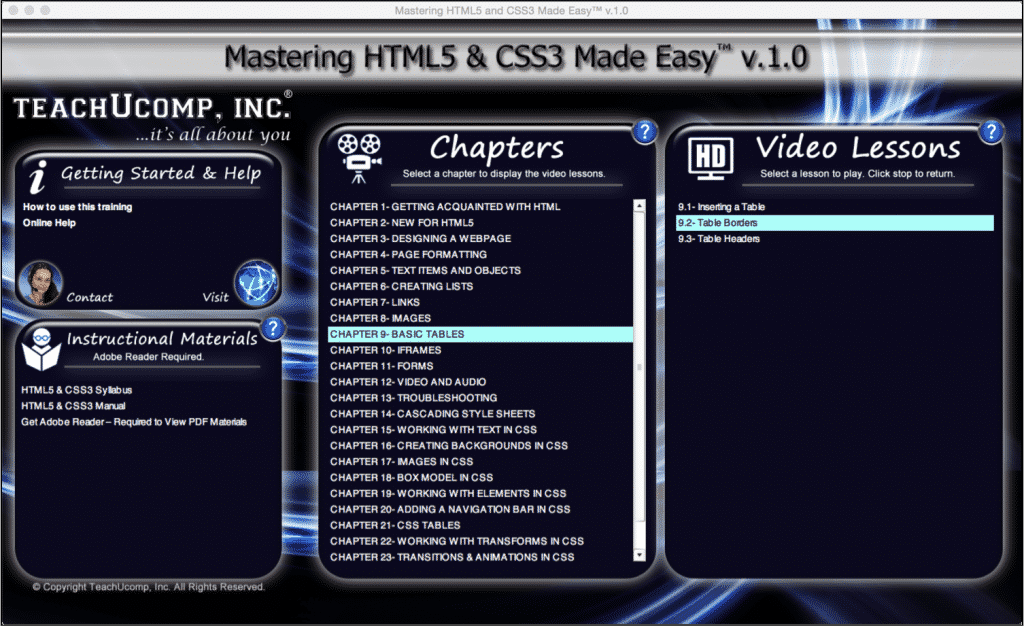HTML Terminology- Tutorial
HTML Terminology: Video Lesson
This video lesson, titled “Introduction to HTML Terminology,” discusses basic HTML terminology. This video on HTML terminology is from our complete HTML5 and CSS3 training, titled “Mastering HTML5 & CSS3 Made Easy v.1.0.”
HTML Terminology: Overview
In this lesson, you will learn some basic HTML terminology. HTML is the language used to create webpages. HTML stands for Hypertext Markup Language. HTML documents written with this text (or coding) tell browsers how to interpret and display the data.
HTML documents can be identified by the file extension .htm or .html. HTML standards are set and maintained by an international group of industry leaders such as Microsoft and Apple, called The World Wide Web Consortium (W3C). The rules that govern how HTML is written are called syntax. As new Web technologies emerge, HTML evolves through the W3C with newer versions such as 5.0 that introduced new standards discussed in upcoming chapters.
The “Markup Language” component of HTML refers to the insertion of instructions, called tags. Tags tell the Web browser how to interpret the data. Tags follow a standard format. Each tag begins with a “less than” symbol (<), immediately followed by the tag text, and ending in a “greater than” symbol (>). Spelling is critical, as tags not recognized by a Web browser are ignored. Tags in HTML can be written in either upper or lowercase. However, it is considered generally good practice to type your tags in lower case.
Tag Example: <body>
Most tags have a similar counterpart, called an “end tag” which stops the effect of the tag. An end tag is identical to the start tag counterpart, but also includes a forward slash “/”immediately before the tag text. Some tags do not have a closing counterpart, such as the Image tag (<img>). A closing tag must always include the forward slash “/”.
End Tag Example: </body>
Elements are simply the different components or pieces of your webpage (text, images, etc.). For example, <body>…</body> are tags that identify the body text on a webpage.
Once you have identified the element, you can then apply attributes such as color and alignment to the element. Many attributes require that you also set a value, such as a measurement or specification. For example, if you wanted to center a paragraph on your webpage, the code would read:
Attribute Example: <p style=“text-align:center”>Your paragraph text.</p>
In this example, STYLE is the attribute for the paragraph’s text and text-align:center is the value. Values are always surrounded by quotation marks. You can apply multiple attributes, separating them with space between.
Entities are special characters you can add to a page such as a copyright or trademark symbol. Entities begin with an ampersand (&) and end with a semicolon. For example, the code to insert a registration mark (®) looks like:
Entity Example: ®
As HTML became more prevalent and the need increased for additional structure for HTML documents, the W3C introduced XML (Extensible Markup Language), a meta-markup language used to create other languages and allow developers to define their own tags. XML isn’t quite as flexible as HTML, so the W3C rewrote HTML in XML, creating XHTML.
With the advent of HTML5, the W3C recommends using HTML5, as its inclusion of the extensive use of Cascading Style Sheets (CSS) and JavaScript (JS) has eradicated the need for XHTML. While XHTML is still being supported by browsers, its similarity to the latest iteration of HTML makes it redundant.


